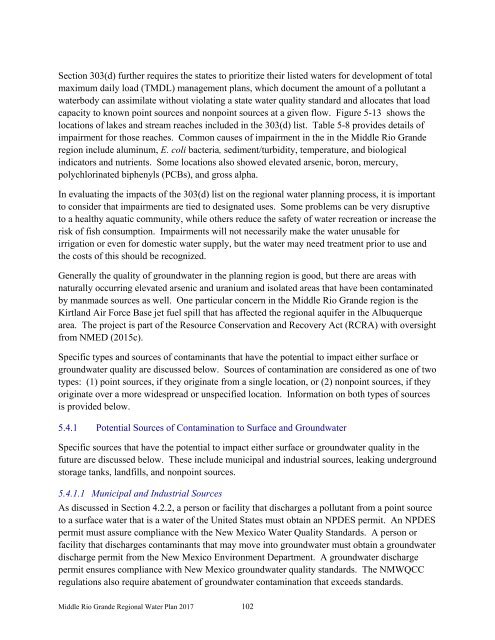Middle Rio Grande Regional Water Plan
2iUWd5b
2iUWd5b
Create successful ePaper yourself
Turn your PDF publications into a flip-book with our unique Google optimized e-Paper software.
Section 303(d) further requires the states to prioritize their listed waters for development of total<br />
maximum daily load (TMDL) management plans, which document the amount of a pollutant a<br />
waterbody can assimilate without violating a state water quality standard and allocates that load<br />
capacity to known point sources and nonpoint sources at a given flow. Figure 5-13 shows the<br />
locations of lakes and stream reaches included in the 303(d) list. Table 5-8 provides details of<br />
impairment for those reaches. Common causes of impairment in the in the <strong>Middle</strong> <strong>Rio</strong> <strong>Grande</strong><br />
region include aluminum, E. coli bacteria, sediment/turbidity, temperature, and biological<br />
indicators and nutrients. Some locations also showed elevated arsenic, boron, mercury,<br />
polychlorinated biphenyls (PCBs), and gross alpha.<br />
In evaluating the impacts of the 303(d) list on the regional water planning process, it is important<br />
to consider that impairments are tied to designated uses. Some problems can be very disruptive<br />
to a healthy aquatic community, while others reduce the safety of water recreation or increase the<br />
risk of fish consumption. Impairments will not necessarily make the water unusable for<br />
irrigation or even for domestic water supply, but the water may need treatment prior to use and<br />
the costs of this should be recognized.<br />
Generally the quality of groundwater in the planning region is good, but there are areas with<br />
naturally occurring elevated arsenic and uranium and isolated areas that have been contaminated<br />
by manmade sources as well. One particular concern in the <strong>Middle</strong> <strong>Rio</strong> <strong>Grande</strong> region is the<br />
Kirtland Air Force Base jet fuel spill that has affected the regional aquifer in the Albuquerque<br />
area. The project is part of the Resource Conservation and Recovery Act (RCRA) with oversight<br />
from NMED (2015c).<br />
Specific types and sources of contaminants that have the potential to impact either surface or<br />
groundwater quality are discussed below. Sources of contamination are considered as one of two<br />
types: (1) point sources, if they originate from a single location, or (2) nonpoint sources, if they<br />
originate over a more widespread or unspecified location. Information on both types of sources<br />
is provided below.<br />
5.4.1 Potential Sources of Contamination to Surface and Groundwater<br />
Specific sources that have the potential to impact either surface or groundwater quality in the<br />
future are discussed below. These include municipal and industrial sources, leaking underground<br />
storage tanks, landfills, and nonpoint sources.<br />
5.4.1.1 Municipal and Industrial Sources<br />
As discussed in Section 4.2.2, a person or facility that discharges a pollutant from a point source<br />
to a surface water that is a water of the United States must obtain an NPDES permit. An NPDES<br />
permit must assure compliance with the New Mexico <strong>Water</strong> Quality Standards. A person or<br />
facility that discharges contaminants that may move into groundwater must obtain a groundwater<br />
discharge permit from the New Mexico Environment Department. A groundwater discharge<br />
permit ensures compliance with New Mexico groundwater quality standards. The NMWQCC<br />
regulations also require abatement of groundwater contamination that exceeds standards.<br />
<strong>Middle</strong> <strong>Rio</strong> <strong>Grande</strong> <strong>Regional</strong> <strong>Water</strong> <strong>Plan</strong> 2017 102


